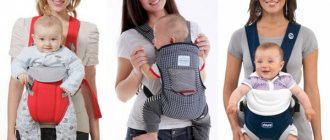Contact lenses are perhaps the best means of vision correction for children. Why is this so? In what cases and at what age can contact lenses be prescribed to a child? What contact lenses are the best choice for him? How can I help my child learn to use contact lenses? Let's discuss these issues further.
- Benefits of wearing contact lenses
- Indications for the use of contact lenses for children
- At what age can you wear contact lenses?
- How to help your child learn to use contact lenses
- Which contact lenses are suitable for children?
In what cases can you wear contact lenses?
Wearing these vision correction devices is permissible only if this type of correction is prescribed by an ophthalmologist.
Most often, young patients are prescribed glasses, but for a number of reasons, children do not like such optics; most often they explain this by the fact that because of their peers they treat them worse, tease and insult them.
Currently, parents themselves are against wearing glasses, since lenses are considered more effective optics, which is preferable for the following pathologies and diseases :
- astigmatism;
- myopia;
- farsightedness;
- congenital cataract;
- keratoconus;
- an affect that manifests itself from the moment of birth.
Important! Another reason to use contact lenses is intolerance to glasses, which can be psychological and physical.
Indications for the use of contact lenses for children
Indications for the prescription of contact lenses for infants and minors are:
- congenital aphakia (lack of lens),
- congenital cataract,
- intolerance to glasses (both physiological and psychological),
- amblyopia,
- myopia,
- farsightedness,
- astigmatism, etc.
Myopia (nearsightedness) . The results of many studies have shown that wearing both soft and hard gas permeable contact lenses helps slow the progression of myopia, and in some cases even stabilize it. Hypermetropia (farsightedness) . Prescribing contact lenses to patients with high degrees of hyperopia is not only a more aesthetic, but also a more physiological type of vision correction. In contact lenses, the child sees objects of true size and perceives them at the distance at which they actually are, in contrast to spectacle vision correction, in which objects are assessed as larger and closer, which negatively affects the child’s psyche and increases the risk of injury. Astigmatism . In addition to the fact that astigmatism reduces visual acuity, it sometimes leads to the development of strabismus and amblyopia and can cause illness in the child. Anisometropia is a condition in which the refraction of the right and left eyes differs. In cases of a refractive difference of more than 3.0 diopters, the child uses the best - dominant - eye, and the image from the worse-seeing eye is suppressed by the brain, and this eye does not participate in the formation of the visual image. Congenital anisometropia, as a rule, is one of the reasons for the development of amblyopia, or “lazy eye”. High anisometropia is a direct indication for the selection of contact lenses. Aphakia (lack of lens) . The optimal vision correction for children after removal of both congenital and traumatic cataracts today is contact correction. With unilateral aphakia, correction with glasses is simply impossible. Firstly, due to the fact that the child has a very large difference in refraction between the eyes and in the optical power of the spectacle lenses; Accordingly, the difference in the weight of the lenses is very large, so the glasses on your face will always be skewed. Secondly, wearing glasses with unilateral aphakia causes aniseikonia, a condition in which the image of the same object is perceived differently in size by each eye.
Of course, a specialist can prescribe contact lenses to minor children only with the consent of their parents or guardians. The child’s wishes should also be taken into account
Benefits of wearing contact lenses at an early age
Compared to glasses, contact lenses have the following advantages :
- When concentrating your gaze on various objects, their shapes, colors and sizes are not distorted.
- Visual acuity improves more noticeably.
- In most cases, these models make it possible to stop the development of vision defects.
- Properly selected products do not cause discomfort.
- During games or sports, the lenses do not interfere and are not a potential source of injury.
At what age can children wear lenses?
Experts have differing opinions about the age at which contact lenses can be worn for children.
Some argue that this is only permissible for children 11 years old, and for some, even the age of 6 years and younger does not become a reason for restricting the wearing of products .
But logically, the acceptable age for wearing these vision correction devices can be considered 10 years and older , since it is at this age that a child can already learn to put on and take off optics independently, and can also take a responsible approach to storing and caring for optics.
Important! However, in ophthalmology there have been recorded cases where this optics was prescribed to infants aged 1-2 years, but such situations were caused by the presence of congenital diseases in rare forms and manifestations.
Terms of use
How to properly care for contact lenses and use them correctly? Before putting on your optics, you should always wash your hands and rinse your lenses with a special solution. Always carefully inspect the optics for defects and correct arc placement, otherwise there will be poor contact with the corneal layer of the eye.
The eyelids need to be spread wide with your fingers and held in this position with one hand. The second hand takes the lens (the finger is in contact with its outer layer) and applies it to the cornea. At this moment you cannot blink so as not to interfere with the action. At first, the blink reflex will dominate, but after a while you will get used to the procedure. After contact of the optics with the eye, you should blink for a while so that the eye adapts to the implant.
How to properly remove optics from eyes? To do this, you need to tilt your head back a little and look up. After this, move the lens down with your finger and remove it from the eye with your fingers.
Care and storage of contact optics
Where are reusable optics stored? There are special containers and sterile solution for this. Models intended for constant wear should be periodically cleaned with liquid. You can read about the proper cleaning and storage of optics in the instructions included with the products.
Important! You should not skimp on lenses; this can damage your visual organs.
One-day models do not need to be cleaned; they are thrown away after use. If the optic is not intended for night wear, it should be removed. If you don't do this, your vision will deteriorate over time.
Cleansing rules:
- remove the lenses, drop a little cleaning liquid on the inner surface,
- gently wipe the surface with your fingertip,
- Immerse the cleaned lens in the container containing the solution.
The storage container also needs to be cleaned periodically. What do we have to do? Every morning, pour out the solution and rinse the container with running water, then leave to dry. In the evening, fill the container with fresh optical storage solution and place the disinfected lenses in it.
Remember that a special liquid is required to process rigid structures. This liquid is not suitable for processing soft optics.
Optimal models and specifics of their application
It is believed that it is better to wear daily lenses, which do not need to be cared for and monitored, although it is acceptable for an older child to use monthly scheduled replacement models. In such cases, it is necessary to clearly explain the rules for caring for optics.
It is better not to purchase models designed for quarterly, semi-annual or annual replacement, since deposits form on such products over time , which can cause various ophthalmological pathologies. Adults are less susceptible to this.
When it comes to children, there is also a difference in the materials from which the models are made . In particular, you should not purchase hard models that can injure the sensitive organs of vision. But in some cases, just such optics are prescribed (for severe myopia and keratoconus).
The modern ophthalmic market provides the opportunity to choose various models made of silicone hydrogel .
These are the most comfortable and convenient products that do not irritate the eyes and are completely safe from the point of view of the possibility of injury to the eyeball .
Children and contact lenses
Ophthalmologists prescribe contact lenses for children from the age of eight or ten. There are two types of lenses produced for children - daytime (soft) and nighttime (hard). The optics are selected and prescribed by an ophthalmologist; you cannot choose lenses yourself. The doctor tells you how to put on the optics correctly, how to care for them and when to replace them.
Small children are recommended to wear disposable models that do not require special care and storage. Planned lenses, which are replaced every two weeks, are not prescribed to children.
Note! Improper care and storage of lenses can cause the development of eye infections.
What parents need to know about the use of contact lenses by children:
- For children under ten years of age, it is better to wear one-day models, putting on new lenses each time. However, the high cost of this product should be taken into account.
- School-age children are responsible for carrying out their parents' instructions, so they can be trusted to wear reusable models under the supervision of their elders.
- Teenagers can wear decorative colored optics, but no more than three hours a day.
Teenage children strive to stand out among their peers. Sometimes schoolchildren ask their parents to buy them colored or tinted contact lenses. Can minors be allowed to wear decorative optics?
This can be allowed, but the penalties for abuse should be clarified. Excessive contact of the optics with the cornea of the eyes can cause inflammatory or infectious processes. If a child understands the extent of responsibility for his health, you can buy him decorative overlays.
Side effects
Are there any side effects or complications from wearing contact lenses? If you try to wear products that have expired, all sorts of troubles may arise - cracks on the surface, accumulation of microbes. This may damage the corneal layer and cause inflammation: the eyes will become red and itchy.
Are contact lenses safe for children?
Contact lenses are safe optics, but only if the rules for wearing and caring for them are followed. In addition , it is important that the child himself understands the need to observe hygiene rules .
Important! The only danger that may arise when using these products is the occurrence of dry eye syndrome when wearing the product beyond the specified period and at night (the only exception is orthokeratology night products).
Do lenses help with vision correction?
Myopia, which often develops mainly at school age, tends to progress rapidly, so in most cases it is impossible to cure such a disease only with the help of lenses.
This is due to the fact that children constantly experience heavy visual load during their studies, for which young and not fully developed visual organs are not yet prepared .
Opinions among ophthalmologists are divided as to whether these products can help stop the development of diseases. Some argue that it is impossible to slow down the development of the disease with such optical instruments, while others are confident that this is an effective method (especially when it comes to myopia).
But for night lenses, which are used to correct defects in the eyeball that cause refractive errors, many agree on the effectiveness.
Types of contact optics
The medical industry offers several types of eye optics, differing in material and purpose. Lenses are:
- soft and hard
- medical and cosmetic,
- daily and permanent
- frequent/infrequent replacement,
- different shapes,
- with different percentages of water content,
- spherical and aspherical,
- toric and bifocal.
Soft models are most often used, as they are used to correct various types of ophthalmological diseases. Rigid optics are used to fix the eyeball in cases of strabismus and other severe eye pathologies. Hard models break easily from mechanical stress, while soft models simply bend and then straighten.
Medical optics are intended for vision correction. These lenses are available in diopters. Cosmetic optics are designed to change the color or shade of the eyes. These are ordinary plastic gaskets designed to decorate or hide congenital defects of the cornea or the absence of the iris.
Day lenses must be removed at night, while night lenses are intended for constant use. Frequent replacement optics do not require storage - the lenses are thrown away and new ones are put on every day. These models are sold immediately in large quantities and are inexpensive.
Rare replacement optics are worn for a month or 3 months. These lenses require careful care, as do the storage containers. These models are prescribed to people with severe visual impairment. For minor vision correction, one-day patches are sufficient.
Note! To correct astigmatism, it is better to choose toric lenses.
Depending on the distribution of dioptric power, lenses are spherical and aspherical. Spherical models are distinguished by a uniform distribution of curvature over the surface, while aspherical models have better dioptric characteristics. There is also a toric surface shape with two dioptric powers: these optical devices correct not only visualization, but also refraction.
Bifocal models also have two diopter powers, but do not correct astigmatism. Orthokeratology lenses are used to treat astigmatism - they correct the irregular shape of the cornea.
Soft lenses
These optical devices improve the visualization of objects without distorting their actual shape and volume. Glasses cannot provide clear visualization without distortion because they do not fit tightly to the eyes. Constantly wearing soft lenses stops further vision loss and gradually returns vision to normal.
Soft models of optics do not cause discomfort when worn, as they do not limit the mobility of the eyeball and do not cause aesthetic discomfort. Also, these models do not interfere with the natural development of the visual organ, since they do not distort the picture of the surrounding world.
Hard lenses
These models are prescribed to children from ten years of age in case of incompatibility of the eyes with soft structures. Athletes also use hard optics, since soft lenses can be washed away by water (when swimming in a pool) or blown away by the wind (some sports). Rigid structures are also prescribed for:
- active progression of myopia,
- astigmatism and lens deformation,
- pathology of the corneal layer.
These pads are worn for six months, but not more than a year. Optics correct visual function and stop progressive myopia.
Can I wear contact lenses long term?
Products designed to be worn for a certain period of time are highly undesirable to wear for longer.
Some try to save money by using contact products two or even three times longer than the recommended service life, but in practice this often leads to the formation of certain diseases.
This is explained by the fact that over time, microcracks and scratches appear on such optics, in which pathogenic microorganisms and contaminants accumulate .
Important! It is also worth remembering that products may simply lose their properties after the end of their service life.
As for children, in such cases it is very important not only to prevent wearing products beyond the prescribed period, but also to prevent cases when the child does not take off the products at night (unless these are night optics).
And even the use of orthokeratological products may not always be permissible, therefore, before purchasing night products for a child to eliminate astigmatism or myopia, it is necessary to undergo a complete ophthalmological examination and obtain the approval of the attending physician .











